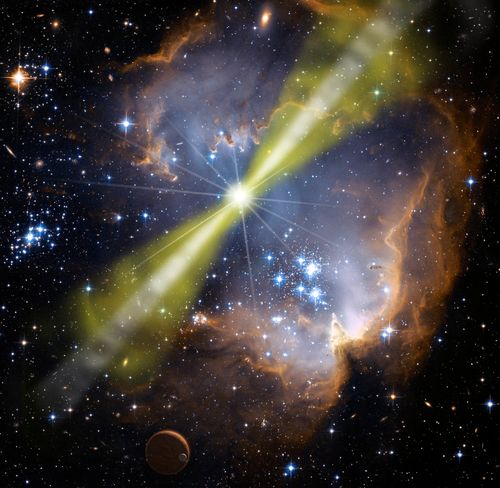
© NASAAn artist's conception of a gamma-ray burst. The GRB is visible from Earth if the jets (yellow) are oriented so that one points toward us.
It came suddenly from the distant reaches of the Constellation Sagittarius, some 50,000 light years away. For a brief instant, a couple of tenths of a second, on December 27, 2004 an invisible burst of energy the equivalent of half a million years of sunlight shone on Earth. Many orbiting satellites electronics were zapped and the Earth's upper atmosphere was amazingly ionized from a massive hit of gamma ray energy.
The source of the invisible attack was a rare magnetar SGR 1806-20 on the other side of the Milky Way. These soft gamma ray repeaters, SGRs, occur when twisted magnetic fields attempt to re-align themselves and crack the magnetar's crust releasing the awesome burst or pulse of energy with a death-zone of a few light years. Magnetars have magnetic fields 1000 times those of ordinary pulsars -so powerful as to be lethal at a distance of 1000 kilometers.
Astronomers have cataloged well over 1000 pulsars, and estimate the number of quiet neutron stars to be vastly more at some 100 million given the 10-billion-year life of the Milky Way's disk. The odds are that one is nearby, gliding silently past Earth, of no danger. The tonest fraction of neutron stars have morphed into magnetars, believed to be the offspring of the most massive stars, hypergiants that don't have enough mass to evolve into black holes.
Fortunately for Earth, the nearest GRB candidate seems to be thousands of light-years away. Maybe... Data from satellites and observatories around the globe showed a jet from a powerful stellar explosion witnessed on March 19, 2008 aimed almost directly at Earth.
NASA's Swift satellite detected the explosion - formally named GRB 080319B - at 2:13 a.m. EDT that morning and pinpointed its position in the constellation Bootes. The gamma-ray burst became bright enough for human eyes to see. Observations of the event are giving astronomers the most detailed portrait of a burst ever recorded.



Comment: One wonders if it was possible trigger of the 2004, Boxing Day tsunami?